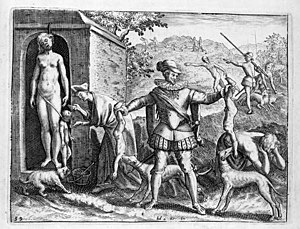黒い伝説
 ウィキペディアから無料の百科事典
ウィキペディアから無料の百科事典

黒い伝説(くろいでんせつ、スペイン語: La Leyenda Negra、英語: Black Legend)は、スペイン帝国の評判を貶めることを意図して、同国を悪の存在として描いた客観性を欠いた歴史的資料またはプロパガンダである。
概要[編集]
黒い伝説は元々、16世紀のヨーロッパ植民地主義の激しい対立の最中に作成されたものである。最初にこれを伝説であると解説・批判したのは、1914年に公開されたJulián Juderíasの著書The Black Legend and the Historical Truth(西: La Leyenda Negra y la Verdad Histórica)であり、同著では何故史学史においてスペインの歴史にこのような深いネガティブなバイアスがかかってしまったのか、何故正の側面が無視されてきたのかを説明した。こうした反スペインの間違った歴史を指す言葉として、Juderíasは新たに「黒い伝説」という造語を作成した。後に他の研究者も彼の考えを支持し、歴史家のCharles Gibsonは1958年、スペイン及びスペイン帝国は、歴史において事実を超えて、残虐で偏屈で搾取的でかつ独善な存在として扱われていると語っている。[1][2]
定義[編集]
Juderíasは自著において、「黒い伝説」を以下のように定義している。[3]
"The environment created by the fantastic stories about our homeland that have seen the light of publicity in all countries, the grotesque descriptions that have always been made of the character of Spaniards as individuals and collectively, the denial or at least the systematic ignorance of all that is favorable and beautiful in the various manifestations of culture and art, the accusations that in every era have been flung against Spain."[4]—Julián Juderías、La Leyenda Negra
Philip Wayne Powellもまた、彼の著書Tree of Hateにおいて「黒い伝説」をこう定義している。[5]
"An image of Spain circulated through late sixteenth-century Europe, borne by means of political and religious propaganda that blackened the characters of Spaniards and their ruler to such an extent that Spain became the symbol of all forces of repression, brutality, religious and political intolerance, and intellectual and artistic backwardness for the next four centuries. Spaniards … have termed this process and the image that resulted from it as ‘The Black Legend,’ la leyenda negra"—Philip Wayne Powell、Tree of Hate (1985),
Fernández Álvarezはまた、「黒い伝説」をより幅広く定義している。
"The careful distortion of the history of a nation, perpetrated by its enemies, in order to better fight it. And a distortion as monstrous as possible, with the goal of achieving a specific aim: the moral disqualification of the nation, whose supremacy must be fought in every way possible."[6]—Alfredo Alvar、La Leyenda Negra (1997:5)
白い伝説[編集]
白い伝説は、黒い伝説の対義語として歴史家により用いられる語句で、黒い伝説に対抗するあまり、スペインの植民地化に対して無批判や理想化をしてしまうことを指す。[7] この語句は特にフランコ政権期のスペインにおいてナショナリズムに基づいた歴史観を説明する際に用いられる。[8] Benjamin Keenらは、例えばJohn FiskeやLewis Hankeをスペインの歴史を過度に理想化しすぎていると批判している。[9]
脚注[編集]
- ^ Gibson, Charles. 1958. "The Colonial Period in Latin American History" pages 13-14 defines the black legend as "The Accumulated tradition of propaganda and Hispanophobia according to which Spanish imperialism is regarded as cruel, bigoted, exploitative and self-righteous in excess of reality"
- ^ *Immigration and the curse of the Black Legend
- ^ Juderías, Julián, La Leyenda Negra (2003; first Edition of 1914) ISBN 84-9718-225-1
- ^ "el ambiente creado por los relatos fantásticos que acerca de nuestra patria han visto la luz pública en todos los países, las descripciones grotescas que se han hecho siempre del carácter de los españoles como individuos y colectividad, la negación o por lo menos la ignorancia sistemática de cuanto es favorable y hermoso en las diversas manifestaciones de la cultura y del arte, las acusaciones que en todo tiempo se han lanzado sobre España..."
- ^ Powell, Philip Wayne, 1971, "Tree of Hate" (first Ed.) ISBN 9780465087501
- ^ ...cuidadosa distorsión de la historia de un pueblo, realizada por sus enemigos, para mejor combatirle. Y una distorsión lo más monstruosa posible, a fin de lograr el objetivo marcado: la descalificación moral de ese pueblo, cuya supremacía hay que combatir por todos los mediossine die.»
- ^ Keen, Benjamin. 1969. "The Black Legend Revisited: Assumptions and realities". The Hispanic American Historical Review. volume 49. no. 4. pp.703-719
- ^ Molina Martínez, Miguel. 2012. "La Leyenda Negra revisitada: la polémica continúa", Revista Hispanoamericana. Revista Digital de la Real Academia Hispano Americana de Ciencias, Artes y Letras. 2012, nº2 Disponible en: < http://revista.raha.es/>. ISSN 2174-0445
- ^ Walsh, Anne L. (2007). Arturo Pérez-Reverte: narrative tricks and narrative strategies. Colección Támesis: Monografías (Volume 246). London: Tamesis Books. p. 117. ISBN 1-85566-150-0